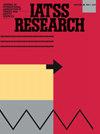Understanding the changes in long-distance travel behavior due to socio-economic and pandemic drivers
IF 3.3
Q3 TRANSPORTATION
引用次数: 0
Abstract
The unprecedented COVID-19 pandemic massively affected the long-distance trips all over the world. Like other countries worldwide, inter-regional mobility restrictions with the capital city were also imposed in Bangladesh to control the spread of coronavirus. Therefore, it is important to examine the changes in long-distance travel behavior to understand people's mobility needs and responses during travel restrictions, as well as the influences of individuals' socio-economic conditions and the country's COVID severity on their travel decisions. Data for this research were collected from 402 respondents in Dhaka using online questionnaires. Voluntary response and convenience sampling techniques were followed in this study. Moreover, district-wise COVID data was obtained from the dashboard of Directorate General of Health Services (DGHS). Descriptive statistics and spatial analyses were employed in this study. In addition, binary logistic regression model and mixed-effect logistic regression model were developed to understand the underlying factors behind the changes in long-distance travel behavior during the pandemic. The findings reveal that the majority of the respondents decreased their long-distance trips during the first pandemic wave. A notable percentage of trip makers' long-distance trip patterns and mode use remained the same as their pre-pandemic situation. Access to private cars was a positive determinant for long-distance trips during the pandemic; hence, the excess cost of private transportation compelled people to use risky public transportation. The presence of elderly individuals and children in households reduced the likelihood of traveling longer distances during the pandemic. Hygiene and safety from COVID-19 contamination were the main concerns for respondents while choosing long-distance travel modes. Individuals' high-risk perception regarding COVID-19 decreased the probability of traveling longer-distance during the pandemic. In general, travelers relatively less preferred COVID hotspots as their long-distance trip destinations during the first pandemic wave. This study's recommendations will assist planners and policymakers in designing a safe and affordable long-distance transport corridor during future pandemics.
了解社会经济和流行病驱动因素导致的长途旅行行为的变化
前所未有的新冠肺炎大流行严重影响了世界各地的长途旅行。与世界其他国家一样,孟加拉国也实施了与首都的区域间流动限制,以控制冠状病毒的传播。因此,研究长途旅行行为的变化,以了解人们在旅行限制期间的出行需求和反应,以及个人的社会经济条件和国家的COVID严重程度对其旅行决策的影响,具有重要意义。这项研究的数据是通过在线问卷从达卡的402名受访者中收集的。本研究采用自愿回答和方便抽样的方法。此外,从卫生服务总局(DGHS)的仪表板获得了各地区的COVID数据。本研究采用描述性统计和空间分析。此外,还建立了二元logistic回归模型和混合效应logistic回归模型,以了解疫情期间长途旅行行为变化背后的潜在因素。调查结果显示,大多数答复者在第一波大流行期间减少了长途旅行。很大比例的旅行者的长途旅行模式和模式使用与大流行前的情况相同。在大流行期间,获得私家车是长途旅行的积极决定因素;因此,私人交通的超额成本迫使人们使用有风险的公共交通。在大流行期间,家庭中有老年人和儿童减少了长途旅行的可能性。受访者在选择长途旅行方式时主要考虑的是COVID-19污染的卫生和安全问题。个人对COVID-19的高风险认知降低了大流行期间长途旅行的可能性。一般来说,在第一波大流行期间,旅行者相对不太喜欢将COVID热点地区作为长途旅行目的地。这项研究的建议将有助于规划人员和决策者在未来大流行期间设计一条安全且负担得起的长途运输走廊。
本文章由计算机程序翻译,如有差异,请以英文原文为准。
求助全文
约1分钟内获得全文
求助全文
来源期刊

IATSS Research
TRANSPORTATION-
CiteScore
6.40
自引率
6.20%
发文量
44
审稿时长
42 weeks
期刊介绍:
First published in 1977 as an international journal sponsored by the International Association of Traffic and Safety Sciences, IATSS Research has contributed to the dissemination of interdisciplinary wisdom on ideal mobility, particularly in Asia. IATSS Research is an international refereed journal providing a platform for the exchange of scientific findings on transportation and safety across a wide range of academic fields, with particular emphasis on the links between scientific findings and practice in society and cultural contexts. IATSS Research welcomes submission of original research articles and reviews that satisfy the following conditions: 1.Relevant to transportation and safety, and the multiple impacts of transportation systems on security, human health, and the environment. 2.Contains important policy and practical implications based on scientific evidence in the applicable academic field. In addition to welcoming general submissions, IATSS Research occasionally plans and publishes special feature sections and special issues composed of invited articles addressing specific topics.
 求助内容:
求助内容: 应助结果提醒方式:
应助结果提醒方式:


